Part 2. MMA West Australian operations
A pictorial history compiled by Geoff Goodall
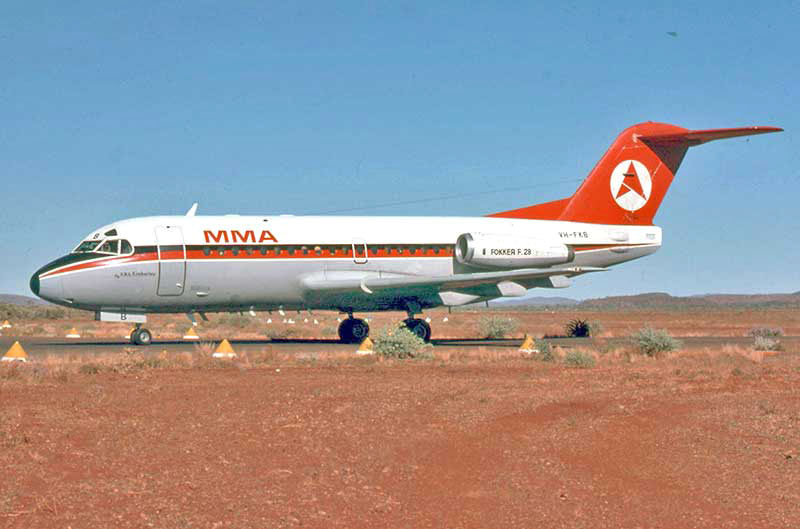
in the Pilbara region in the north of Western Australia, August 1976. Photo by Geoff Goodall
WAA began Australia's first airline service in December 1921 when it commenced this long distance route over unpopulated harsh terrain. (See West Australian Airways in this series) WAA had developed the route into a reliable air service before launching the equally long distance Perth-Adelaide route in 1929. WAA was an impressive operation with sound financial backing, known around the world. By contrast MMA was a little-known charter company which flew modest airline services in South Australia with a single aging Fokker Universal.
The Prime Minister Mr. Joseph Lyons announced on 20 April 1934 the results of the Government review of airline routes in preparation for the United Kingdom-Australia Air Mail. The Perth-Wyndham service was awarded to MMA, including a route extention to Daly Waters NT* to meet the mail plane to/from UK. WAA would cease Perth-Wyndham in September 1934 when the air service would be taken over by MMA which had ordered three new DH.84 Dragon six-passenger airliners from England.
- Singapore-Darwin-Daly Waters-Charleville-Brisbane
- Daly Waters-Perth
- Charleville-Cootamundra
- Melbourne-Hobart
Australian airlines were invited to submit tenders for the Government airmail subsidy which would be paid on all these routes. Tenders closed on 31 January 1934. Amid much secrecy, airlines worked to come up with the all-important "pence per mile" rate to undercut the competition but remain profitable. Some companies submitted multiple tenders with variations in level of service, aircraft type etc. There was also drama, such as Arthur Butler at Cootamundra finalising his tender for the Charleville-Cootamundra route too late to be mailed to the Civil Aviation Branch in Melbourne by the deadline. He flew his Puss Moth through bad weather to Melbourne to hand-deliver his tender documents in time. It was worth the effort for Butler - he was awarded the route and his newly-formed Butler Air Transport was to grow into a significant airline. Holyman's Airways, already operating Tasmania-Melbourne, kept the Hobart connection.
Qantas Ltd, Brisbane in conjuction with Imperial Airways, London was awarded Singapore-Darwin-Daly Waters*-Charleville-Brisbane, using the untried DH.86 four-engined biplanes under new company name Qantas Empire Airways Ltd.
In Adelaide during 1933 Horrie Miller had watched developments with the UK-Australia air mail route review. His South Australian airline services had suffered badly during The Great Depression of the early 1930s when routes had been cut back or dropped. He was friendly with WAA pilots at Parafield flying the WAA Perth-Adelaide service, and listened to their stories of the NorWest coastal service. Becoming intrigued by the possibility of bidding for the new Perth-Daly Waters route, Miller's cost calculations allowed a bid well below the pence-per-mile rate believed being paid to WAA for the existing service. He took his figures to the manager of the MacRobertson's business office in Adelaide, where they were checked by the accountants and confirmed. Delay in gaining an appointment with Sir Macpherson Robertson in Melbourne led Horrie to make a 3am departure from Parafield in his DH.60 Moth with the hapless manager as passenger. They were waiting outside Robertson's office at 8am when "Mr. Mac"arrived at the beginning his business day. He gave them time for Miller to briefly explain his proposal, questioned his Adelaide manager about the costings, then agreed to finance this unexpected expansion for MMA. The Adelaide pair immediately flew home to commence preparing the formal Tender documents.
*Daly Waters was substituted for the originally specified Katherine NT as the northern connection for the Perth airmail route. During his route survey in the Moth, Miller was pleased to find a substantial hangar at Daly Waters, one of the few along the route, and requested the northern MMA terminus be changed from Katharine 170 miles north. All parties agreed and by the time of MMA's first service in October 1934, the route was Perth-Daly Waters.


True to character, the frugal Horrie Miller is wearing the same sweater he wore on the route survey above.
The Dragons were delivered painted dark blue with silver wings and tailplanes and allocated names of WA regions:
VH-URW test flown 29.8.34 "The Pilbara"
VH-URX test flown 12.9.34 "The Gascoyne"
VH-URY test flown 6.9.34 "The Murchison"

The Dragons were delivered painted royal blue, but were soon respayed in silver. Geoff Goodall collection
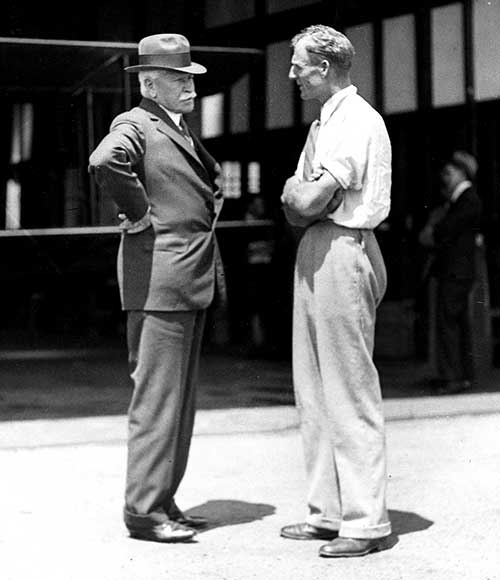
Sir Macpherson Robertson (left) with H.C.Miller at Maylands just prior to the inaugural flight
This rare photograph of the two together was taken by Frank Colquhoun
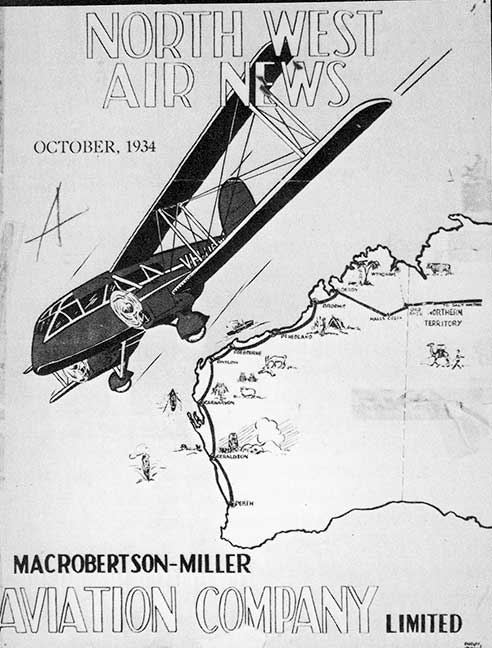
Route distance Perth-Daly Waters was 2,252 miles

Flying in the north was mornings-only, to avoid severe air turbulence later each day as the ground heated up.
The schedule shows a hardy traveller would take 4 days to fly from Perth to Daly Waters.A supplementary Kimberley feeder service to cattle properties between Wyndham to Ord River Station began late that month with the Moth VH-UNX but was suspended when the Moth crashed at Ord River on 9 November 1934. The passenger died, MMA's first fatality. The feeder service resumed the next year when a DH.83 Fox Moth was based at Wyndham.

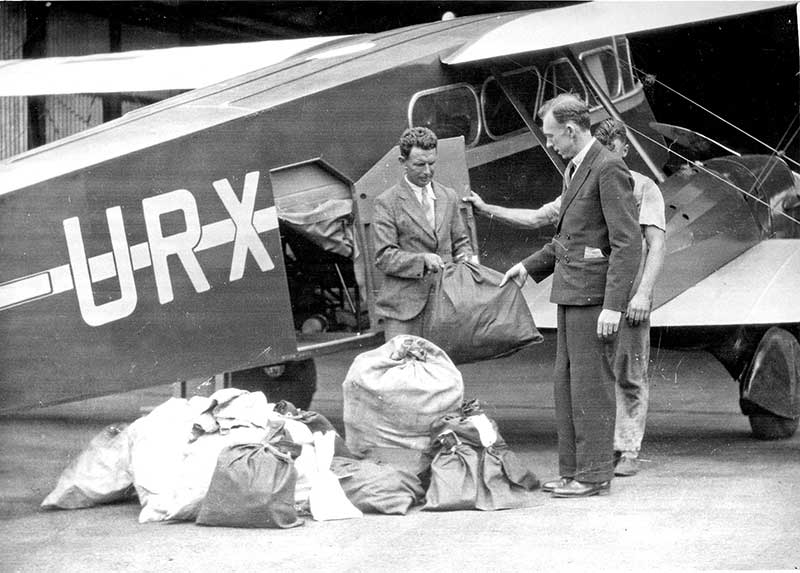
The first International Air Mail from Great Britain being unloaded at Maylands 21 December 1934 just in time for Christmas.
Pilot George McCausland is on the left. Photo: Geoff Goodall collection
Pilot George McCausland is on the left. Photo: Geoff Goodall collection
4.10.34 Dragon VH-URW undercarriage collapse on rough surface during fast taxy and turn on to the strip at Onslow WA by Bert Hussey. No injuries. Passengers and mail tansferred two days later to a replacement DH.84 flown from Perth by Arthur Affleck carrying engineers and parts. Hussey continued the inaugural northbound service.
23.10.34 Dragon VH-URX was wrecked when picked up by a willy-willy (dust devil) while parked at Ord River Station. Pilots George McCausland and Bert Hussey were having lunch in the homestead but managed to grab an interplane strut on each wing. However the aircraft was blown into stockyards ending up on its back. Horrie Miller flew the Moth VH-UNX from Perth to Ord River to rebuild the Dragon and deliver the Moth to commence a feeder service between Ord River and Wyndham.
Working on his own, in extreme heat, Miller made major repairs to the Dragon, replacing the demolished nose section with a temporary structure he made from plywood panels from tea chests. Some weeks later a company engineer from Perth joined him to help with the lifting for final reassembly, then Miller flew it to Perth. It was fully rebuilt and back in service by mid December that year .
7.11.34 Dragon VH-URY badly damaged in a forced landing among trees and stumps following engine failure on takeoff at Halls Creek WA. Pilot George McCausland and his only passenger, CAB Inspector Jim Collopy were unhurt. The Dragon was again rebuilt by Horrie Miller, who brought a tent and cooking utensils to work on his own. The airfield did not have a hangar to give any shade. Another month's hard work in above 40C temperatures and high humidity every day took its toll - Miller collapsed from heat stroke and exhaustion. He spent time in Wyndham hospital but those close to him believed these months took a toll on his health from which he never fully recovered. He completed the rebuild and ferried the Dragon back to Perth by Christmas 1934.
7.11.34 DH.60M Moth VH-UNX crashed on landing approach to Ord River Station. Newly-hired pilot J. C. Miles was badly injured and his passenger Mr. J. Pike was killed. The nearest doctor was Dr. Ralph Cato at Wyndham, who drove for 22 hours by car on rough dirt roads to reach Ord River. Dr. Clyde Fenton from the Katherine NT hospital arrived in his Moth to fly Miles to Wyndham hospital where he was treated by Drs Cato and Fenton. Miles was flown to Perth as a stretcher patient by Arthur Affleck on the next regular MMA southbound service from Daly Waters.
8.3.35 Dragon VH-URW turned over on to its back landing on the Government-designated emergency landing ground for Wyndham when the wheels dug into the soft surface. The main airfield was under water from monsoonal rains. Pilot Arthur Affleck and his one passenger, who had been grounded at Fitzroy Crossing for the previous two two days because of the rain, were not hurt. Most of the population of Wydham came out to help pull the aircraft back on to its wheels with ropes. A telegram from the Perth office told Affleck that James Woods was flying up with an engineer in a relief Dragon and would land at Ivanhoe Station where the strip was reported to be usable. Affleck was instructed to get the airmail sack to Ivanhoe to meet him, so he rode a horse 50 miles overland to Ivanhoe. Affleck then departed with the northbound mail, taking it direct to Darwin to make up time with the connecting Qantas DH.86 service to Singapore. Woods and the engineer set off by horse to Wydham to make basic repairs to VH-URW and ferry it back to Perth. It returned to service in June 1935.
 |  |
Right: The single-handed repair by Horrie Miller, who made a temporary structure using plywood from tea chests.
Photos: Durack collection, State Library of WA
The London-Melbourne Centenary Air Race October 1934
An
International air race from London to Melbourne was proposed as part of the 1934 Cententary
celebrations for the State of Victoria. Horrie Miller's
financial benefactor Sir Macpherson Robertson in Melbourne agreed to
sponsor the event. Miller, at that time in Adelaide was excited and
keen to be a competitor with an eye on the £10,000 prize money. Learning
that a record-breaking Lockheed Vega was available for sale in England,
he decided this would be a perfect aircraft for the race. His long-time
friend David Robertson, younger brother of Macpherson, agreed to
sponsor Miller's race entry and the Lockheed was purchased. Horrie had
made a persuasive case that after the race the Vega would become a valuable addition
to the MMA fleet as fast charter aircraft.Miller had a high regard for James Woods, West Australian Airways' senior pilot, who he had come to know well during Woods' stop-overs in Adelaide while flying the WAA Perth-Adelaide service. Woods, a quiet but determined Scot, had earlier flown his DH.60M Moth VH-UPD The Spirit of Western Australia solo from Perth to Britain in July 1933 in a record attempt. Miller invited Woods to join him in flying the Lockheed Vega in the International air race scheduled for October 1934 and the pair commenced their planning.
Thus the news of MMA's successful bid for West Australian airmail service must have been a bitter-sweet moment for Horrie Miller. He was to establish a new Perth-based operation to commence services in October 1934, the very same month as the Air Race which he was eagerly anticipating.
One of his first actions in preparation for the WA airline operation was to appoint a Chief Pilot/Route Manager for MMA's West Australian airline services. The obvious choice was Woods, who had a proven record and knew the North-West route, the weather, airfields, towns and people from his many years with WAA. Woods was reluctant to disappoint WAA's Norman Brearley, but accepted MMA's offer. He flew his last WAA service Forrest-Adelaide 13 June 1934 in Dragon VH-URE. Woods wrote to his wife "I feel sorry for Norman, one of the best fellows in the world - when away from aeroplanes and hangars. We are excellent pals still."
Horrie Miller nominated Woods as the pilot in command for his Air Race entry and Jimmy Woods sailed for England to prepare the Vega and engage a copilot/navigator. They agreed he should sail via North America to visit Lockheed in California to learn about the Vega's systems and maintenance. He also ordered spare parts to be shipped to Perth for its use by MMA after the race. In England he inspected the Lockheed Vega G-ABGK which had been parked in a hangar for over a year and set to work to renew its British CofA. As his copilot/navigator, he engaged Don Bennett, an Australian flying for Imperial Airways with a fascination with accurate long distance aerial navigation techniques. D.C.T. Bennett was to go on to a remarkable civil and military flying career rising to the rank of Air Vice Marshal in the wartime RAF when he lead the Pathfinder force and post-war established British South American Airways.
The aircraft in the Centenary Air Race (also referred to as the MacRobertson Air Race) departed Mildenhall Aerodrome, London on 20 October 1934. Woods and Bennett, as race number 36, took off at 6.39am bound for Marseilles, Rome and Athens on the first day. They departed Athens at 3.11am next morning for a daylight arrival at Aleppo, Syria. On landing the port undercarriage leg fractured and collapsed, the port wingtip dug into the ground and the Vega was thrown over on its back. Woods was trapped in the cockpit with a bleeding head injury. Bennett who had been seated at the rear of the cabin for the landing, was flung across the cabin, sustaining three crushed vertebrae and leg injuries. After a spell in hospital, Jimmy Woods arranged to have the wrecked Vega dismantled and packed in sections. It was moved by road to the Turkish port of Alexandretta where loaded on the cargo ship Zafaarar for Perth, while Woods sailed for Perth on P&O Oransay.
 |  |
Right: Don Bennett in 1944 as Air Vice Marshal D.C.T. Bennett of Pathfinders fame



The Vega's rebuild was completed in August 1935 and, painted as VH-UVK made its first test flight at Maylands on 22 August 1935 flown by Horrie Miller. This triggered ten months of bureaucratic hand-wringing at CAB Head Office Melbourne, because of the Government embargo on US built aircraft. The canny Miller had considered this before purchasing the Vega and pointed out that the British Certificate of Airworthiness circumvented the ban. Nevertheless, the CAB response was that it was required to confer with the American and British authorities before it could issue Australian certification. But it allowed the aircraft to be flown for two months.
To answer any implied doubts over the Vega's airworthiness, Miller gladly accepted a long-distance charter for the aircraft: on 13 October 1936 Jim Woods flew VH-UVK from Perth to Adelaide with two passengers in 7 hours 55 mins flying time, a remarkably fast time.
Despite the American aircraft embargo being officially dropped in November 1935, the CAB's stubborn delay dragged on into the following year. The Vega was grounded at Maylands and Miller's letters to CAB became increasingly hostile. Finally on 23 June 1936 Australian Certificates of Registation and Airworthiness for VH-UVK were signed in Melbourne and mailed to MMA in Perth. As well as local flying, these are some of the trips recorded in the aircraft's logbook, all flown by Jimmy Woods:
5.10.36 Perth-Kalgoorlie-Forrest-Ceduna-Blyth-Adelaide: charter 2 passengers: 7 hrs 10 mins flying time
9.10.36 Adelaide-Ceduna-Forrest-Kalgoorlie-Perth: 7hrs 50 mins including 30 minutes aerial search near Zanthus on Nullabor
14.10.36 Perth-Kalgoorlie-Perth, Woods: charter passenger group
17.11.36 Perth-Kalgoorlie-Forrest-Cook-Ceduna-Adelaide: charter two passengers: 7 hrs 25 mins
18.11.36 Adelaide-Ceduna-Forrest-Kalgoorlie-Perth: charter one passenger who was transferred to a waiting Fox Moth to Bunbury
28.8.38 Perth-Carnarvon-Port Hedland: to collect airmail from delayed southbound service from Darwin and carry it to Perth
10.11.38 Perth-Geraldton-Port Hedland-Broome
11.11.38 Broome-Noonkenbah-Fitzroy Crossing-Wyndham-Darwin
14.11.38 Darwin-Wyndham-Halls Creek-Fitzroy Crossing-Noonkenbah-Derby-Broome-Port Hedland
15.11.38 Port Hedland-Whim Creek-Roebourne-Onslow-Carnarvon-Geraldton-Perth

Pictured on 22 August 1935 when Horrie Miller made the first test flight. Photo: Geoff Goodall collection

A pleasing photo taken by chief engineer Frank Colquhoun showing Captain James Woods with the Vega at Maylands

Photo: Geoff Goodall collection
Two more Dragons were acquired and three second-hand DH.83 Fox Moths shipped from England. The 3 passenger Fox Moths proved to be perfect for air mail feeder services in the far north which carried mail sacks and freight but only the occasional passenger. They were fitted to carry a stretcher patient to allow MMA to commence contracts to provide aircraft for the Australian Aerial Medical Service. Commencing with Fox Moths, then Dragons prior to WWII, an aircraft and pilot was based at Port Hedland and Wyndham, to fly for MMA but always be available to the flying doctor service, which saved many lives. MMA was to continue flying doctor operations right through to 1958, during which time the AAMS was renamed Flying Doctor Service of Australia and finally Royal Flying Doctor Service of Australia.

The previous British registration G-ABXS is still on the fuselage sides. Geoff Goodall collection



Photo: Geoff Goodall collection

Neil Follett collection


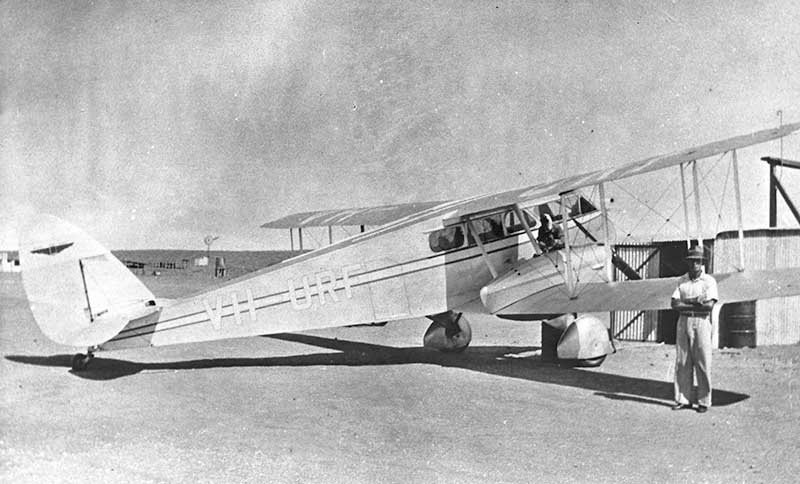
Photo: Geoff Goodall collection


Photo: Horrie Miller collection, National Library of Australia
Meanwhile, years of talks between the Australian and British governments had resulted in the UK-Australia Air Mail undergoing major changes with land planes being replaced by an Empire Air Mail flying boat service to commence in August 1938. Qantas would operate Singapore-Darwin-Brisbane-Sydney with Short S.23 Empires. This caused a rearrangement to the Australian connecting airmail routes. MMA's contract was to be changed to Perth-Darwin return twice weekly, using two DH.86s purchased from Qantas Empire Airways, no longer needed for the land plane airmail service to Singapore. Although still fabric-covered biplanes, these 4 engined DH.86s brought MMA improved size, speed and cabin comfort over the plodding Dragons and were a good stop-gap until the arrival of the Lockheeds. The unaugural DH.86 service for Darwin departed Perth on 1 August 1938.
MMA was also contracted to operate a revised Kimberley feeder service between Wydham and Daly Waters weekly return using Dragons. This Wyndham-based Dragon and pilot would also service the AAMS flying doctor contract.

MMA retained the Qantas names on the two DH.86s, probably to emphasise their previous international service.
Photo: Geoff Goodall collection

DH.86 and rush it to Perth to maintain the postal schedule. Geoff Goodall collection

in a groundloop when landing with a flat tyre. The MMA repair crew worked in average day temperatures of 46 degrees C.
Photo by MMA senior engineer Frank Colquhoun who was in charge of the rebuild
It was planned that VH-ABV would be first delivered from Parafield to Perth. However at 7am on 17 December James Woods taxied out for the ferry flight. While stationary prior to commencing takeoff, the port undercarriage leg gently folded and the left engine and propeller hit the ground. Guinea Airways chief engineer Jack Gething said he could have it repaired within two days, but VH-ABW was hurried readied and Woods had it in Perth in time for the first scheduled MMA Lockheed service to Darwin leaving on 21 December 1938.
After their arrival in Perth, the Electras were painted with company name, now MacRobertson-Miller Aviation Co Ltd, and names on the nose, VH-ABV RMA Gascoyne, VH-ABW RMA Kimberley. They brought much higher ground speed, sturdiness and general reliability to the Perth-Darwin route and allowed one of DH.86s VH-USD to be quickly sold in February 1939 and ferried to India by James Woods.

Photo: Frank Colquhoun

Parafield after VH-ABV was assembled: left to right: H.C.Miller, Norman Adam (Brown & Dureau Ltd), Charles Grugan
(Lockheed engineer), Marshall Headle (Lockheed test pilot), Harold Cook (Guinea Airways chief pilot), Frank Colquhoun
(MMA chief engineer), James Woods (MMA senior pilot), Bob Patterson (MacRobertson's Ltd Adelaide).
(Lockheed engineer), Marshall Headle (Lockheed test pilot), Harold Cook (Guinea Airways chief pilot), Frank Colquhoun
(MMA chief engineer), James Woods (MMA senior pilot), Bob Patterson (MacRobertson's Ltd Adelaide).
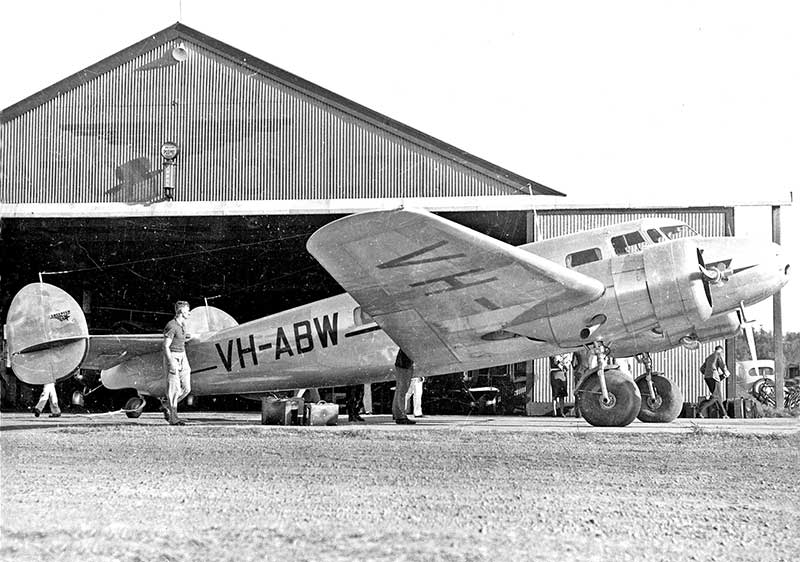
Geoff Goodall collection

Meanwhile back at Parafield, the disheartening scene on 17 December 1938 when VH-ABV's port undercarriage leg folded
just as James Woods was about to depart on delibvery to Perth. It was quickly repaired. Photo by Frank Colquhoun
just as James Woods was about to depart on delibvery to Perth. It was quickly repaired. Photo by Frank Colquhoun

Photo by Frank Colquhoun

| DH.60M Moth | VH-UNX | 1400 | MMA Adelaide. Flown to Perth 6.34 for WA route survey Based WA from 8.34. Crashed Ord River Station 7.11.34 | |
| DH.84 Dragon | VH-URW | 6080 | New | Registered 31.8.34 MMA Perth The Pilbara Sold 22.3.39 to Mandated Airlines, New Guinea |
| DH.84 Dragon | VH-URX | 6081 | New | Registered 11.9.34 MMA Perth The Gascoyne Transferred 9.38 to MMA Adelaide Impressed 12.39 by RAAF as A34-1 |
| DH.84 Dragon | VH-URY | 6082 | New | Registered 11.9.34 MMA Perth The Murchison Sold 13.8.38 to Airlines (WA) Ltd, Perth |
| DH.84 Dragon | VH-URF | 6045 | Purchased 20.11.34 ex Western Mining Corp, Kalgoorlie Named The Kimberley, later Dunbar Hooper II Impressed 5.41 by RAAF as A34-9 | |
| Lockheed DL-1 Vega | VH-UVK | 155 | G-ABGK | Rebuilt Maylands 9.35; Registered 27.8.35 H.C.Miller Impressed 11.11.41 by RAAF as A42-1 |
| DH.83 Fox Moth | VH-USJ | 4058 | G-ACEB | Registered 9.7.35 John Flynn Sold 11.8.41 Aust Aerial Medical Service, Port Hedland |
| DH.83 Fox Moth | VH-UTF | 4039 | G-ACID | Registered 9.7.35 Dunbar Hooper, later John Flynn Sold 14.9.38 to George W. Lewis, Kalgoorlie WA |
| DH.83 Fox Moth | VH-UVL | 4015 | G-ABXS | Registered 6.9.35 wrecked in hangar 11.1.39 by cyclone Port Hedland wreck sold 2.6.39 to Sid Marshall, Sydney, rebuilt |
| DH.84 Dragon | VH-UVN | 6106 | G-AEFX | Registered 10.7.36 The Ashburton destroyed by fire, forced landing 7.1.42 after takeoff from Broome WA, pilot and three passengers unhurt |
| DH.86A | VH-USC | 2307 | purchased 22.7.38 ex Qantas Empire Airways retained QEA name RMA Canberra Impressed 24.9.40 by RAAF as A31-5 | |
| DH.86A | VH-USD | 2308 | purchased 28.7.38 ex Qantas Empire Airways retained QEA name RMA Brisbane sold 9.3.39 to Tata Sons Ltd Aviation, Bombay as VT-AKZ | |
| Lockheed 10A Electra | VH-ABV | 1130 | New | registered 21.12.38 RMA Gascoyne reregistered 10.48 as VH-MMD |
| Lockheed 10A Electra | VH-ABW | 1131 | New | registered 21.12.38 RMA Kimberley crashed 17.6.46 on takeoff Broome WA, no injuries |
| Cessna C.37 | VH-UZU | 357 | Transferred 12.39 from MMA Adelaide retired 9.47, sold 28.9.50 to F.G.Roche, Melbourne Viv | |
| Bristol M1C | VH-UQI | 2819 | Owned H.C.Miller, flown Adelaide-Perth 5.40 then stored Donated .56 to the town of Minlaton SA: dsee Part 1 |
The recently-established Department of Civil Aviation (which replaced the Civil Aviation Branch and Civil Aviation Board under the Department of Defence) wrote to Australian airlines explaining the wartime regulations under which the Australian Government could summarily requisition aircraft and other facilities needed by the military. DCA would act as liaison between civil aviation and military authorities, and the senior men of the Department were to play a pivotal role in maintaining skeleton air services throughout the war.
The air force needed DH.60, DH.82, DH.84 and DH.86 types to establish aircrew training schools across the country as part of the Empire Air Training Scheme. DCA attempted to balance RAAF requirements against civil operators' minimum needs to keep an airline network operating, albeit at a much reduced level. MMA was served with Impressment Requisition Notices for four of its aircraft:
DH.84 VH-URX 27.12.39 delivered to RAAF Point Cook from Adelaide by James Woods. To RAAF A34-1
DH.86 VH-USC 30.9.40 delivered to RAAF Point Cook from Perth by James Woods. To RAAF A31-5
DH.84 VH-URF 5.5.41 delivered to RAAF Essendon from Perth by Horrie Miller. To RAAF A34-9
Vega VH-UVK 11.11.41 delivered to RAAF Point Cook from Perth by Horrie Miller. To RAAF A42-1
The two MMA Lockheed Electras were spared impressment because of their strategic importance in maintaining an effective air route between Perth and northern Australia. The pair were to carry many military personnel to the northern commands and were diverted from WA to Melbourne for several weeks to fill in on ANA services when ANA's Douglas airliners were seconded to carry troops to New Guinea.
The MMA Adelaide operation managed by Cyril Kleinig was closed in late 1939. The remaining airline route was a 3 return services weekly Adelaide-Whyalla-Iron Knob (via various Eyre Peninsula towns) of which one service per week received a Government subsidy. A 1939 Government review of airline service subsidies determined that Guinea Airways at Parafield, already operating DH.89 Rapide services to other SA ports, would take over the Whyalla route effective 6 September 1939. MMA's Dragon VH-URX which had flown the Whyalla service was listed to be impressed by RAAF. Cyril Kleinig closed down the Parafield business and flew the remaining aircraft Cessna C.37 VH-UZU to Perth, departing Parafield at 3.45am on 19 December 1939. Kleinig went on to a long succesful flying and management career with MMA Perth, later replacing Horrie Miller as General Manager .
As the war effort built up, MMA was among airlines selected by RAAF as Authorised Civilian Contractors to carry out scheduled overhauls and crash repairs to RAAF aircraft. MMA was issued Tiger Moths from 9EFTS Cunderdin and Dragons from 35 Squadron Pearce. An additional hangar was built at Maylands for this extra maintenance work. Women were employed to replace men who had joined the armed services. As well as the RAAF maintenance work, MMA carried out repairs on fabric control surfaces removed from US Navy PBY-5 Catalinas based at Nedlands, Perth. US Navy Curtiss Seagull and Vought Kingfisher floatplanes landed on the Swan River along the Maylands airfield boundary on occasion to have work done by MMA.


Photo by Frank Colquhoun
The following afternoon James Woods, who was flying the other Electra northbound, diverted to search for them but was unable to sight the downed Lockheed until he spotted the smoke of a grass fire lit by the crew. In several low runs Woods dropped bundles of relief suppies, then circled the Napier Downs homestead to drop a written message to the manager Ned Delower. He set off with aboriginal stockmen on horses to seach, but took two days to locate the aircraft and its miserable occupants. Delower shot stray cattle to prepare a hearty meal of grilled steak and tinned potatoes, bread butter and jam.
MMA chief engineer Frank Colquhoun had been flown up from Perth in the Cessna C.37, landing at the airstrip of neighbouring Meda Station and reaching the accident site overland. Colquhoun assessed a nearby narrow stretch of ground between billabongs as the only possible landing area for the Cessna to use to fly the passengers out. A week after their forced landing, Jimmy Woods appeared in the Cessna and landed on the rough strip to commence taking the passengers out to Derby, one at a time, followed by Captain Branch because the company urgently needed him to resume flying duties.
Colquhoun, with the help of staff from both stations, dug away the mud under the wings and extended the undercarriage. Woods kept up the shuttle from Derby with food and equipment in over 30 trips over two weeks until the Electra was ready to be towed overland by donkey team to the Napier Downs airstrip. Creeks were crossed using logs, but the aircraft wheels and the donkeys sank in mud many times. Over the next week at the airstrip Colquhoun and Bagwell installed the replacement P&W engine and checked the aircraft throughly. It was the height of The Wet season and the strip was muddy and a big effort was made to harden the surface by burning petrol. They sent a radio message to Derby and Jimmy Woods arrived in the Cessna C.37. Woods and Colquhoun walked the length of the strip and when a slight breeze developed, Woods said it was time. Colquhoun walked in front of the taxying Lockheed to the far end, guiding Woods along the best path but a wheel dropped into a hole. All station hands rushed to help and with full engine power it was moved to the far end and straightend up for the takeoff run. Frank Colquhoun clambered on board and Woods successfully flew them out to Derby. Reg Bagwell then flew the Cessna to Derby. It had been a 5 week exercise but the Lockheed reached Perth on 19 February and returned to service.

Wood logs were piled up at creek crossings for the aircraft's wheels. Photo by Reg Bagwell
Many miles out from Broome inbound they could see the smoke from burning military aircraft on the aerodrome and 16 flying boats destroyed on Broome harbour. After landing, while taxying in thick smoke, a propeller blade struck aircraft wreckage, damaging the blade tip. With another raid expected and injured civilian refugees from the Netherlands East Indies desperate to escape Broome, Woods ordered Fisher to use a metal saw from his tool kit to cut off the damaged tip and cut the other blade tip back to match, to keep the propeller balanced. Woods loaded 22 persons on board his 10-seat Lockheed and flew them to Port Hedland, returning to Broome to collect more survivors.
John Fisher remained at Broome, helping organise the evacuees anxiously waiting to be flown out. He departed several days later on board an American B-24 Liberator, being dropped off at Adelaide still in the clothes he was wearing when he left Wydham.
When returning to Broome later that day, Woods sighted a Dutch Navy Dornier Do24 flying boat on a remote beach well south of Broome. It was X-36 commanded by Flying officr Petschi who was evacuating Java carrying Dutch civilians to Broome. He could not locate Broome at night and landed off the beach. Woods circled and dropped a message written on an passenger airsick bag which he weighted and threw out with a white ribbon. Petschi contacted him on the nominated radio frequency and following Woods' instruction not to betray his position, explained their situation and that they were low on water. On arrival Broome, Woods reported the position of the missing Dornier and on his next trip south dropped a message at the Mardie Station homestead and another message to the Dornier party on the beach.
The following morning Woods again circled the Dornier and could see the occupants were still there with no ground party in sight. He landed at the homestead where the manager told him they had been out all night searching on horse back along the coast without success. Woods took off, carrying the manager to show him the exact location, and dropped bottles of water, milk for the children, a sack of bread and other supplies. He also dropped another message with a map to a windmill with water tank and to tell them to expect to be rescued that afternoon. The Captain then set the Dornier on fire to stop it falling into Japanese hands.
For his efforts helping Dutch civilians and military following the Broome attack, Queen Wilhelmina of The Netherlands bestowed on Captain James Woods the Chevalier of the Order of Orange Nassau.
From the Department of Civil Aviation in Australia he was threatened with pilot licence suspension for flying a damaged aircraft and from his company he was criticised for ruining a valuable propeller.

burning aircraft on the airfield at the top of the picture. Photograph taken from a Japanese arcraft departing for Timor.
David Vincent collection

Frank F. Smith collection

USAAC
B-24A 40-2374 on Broome airfield 3 March 1942.
Photo: Lester Brain collection
On 24 March 1943 VH-ABV was put out of action for five months by a takeoff accident at Port Hedland. It ran off the runway and struck runway obstructions and piles of gravel to the side of the strip, to be used to disable the runway in the event of Japanese invasion. The Lockheed's undercarriage was torn away and it ended up on its belly, although the crew and 5 passengers were not injured. Once again senior engineer Frank Colquhoun was flown in with a repair party. The temporary repair of significant structural damage took nearly three weeks before the Lockheed was ferried to Perth on 10 April for work to be completed in the MMA hangars. Some needed airframe parts could not be acquired due to the war situation, so DCA intervened to have Guinea Airways in Adelaide send the parts from their Lockheed spares inventory. VH-ABV was test flown at Maylands 18 August 1943 by James Woods and quickly returned to service.

Two
views of the accident to VH-ABV at Port Hedland airfield in March
1943.
Photos by Frank Calquhoun

DCA persuaded a reluctant Air Force command to release DH.84 Dragon A34-4 (an impressment ex VH-ABK) with 35 Squadron at RAAF Pearce near Perth. It was handed over to MMA at Maylands on 16 May and issued with a 3 month CofA two days later, resuming its civil registration VH-ABK which was painted in white over the RAAF camouflage. The Electra was test flown on 18 August 1943 after completing repairs at Maylands and the Dragon was handed back to RAAF five days later.
In February 1945 Frank Colquhoun was sent to Queensland to inspect the pair. A31-4 (ex ANA's VH-USW Lepena) was serviceable and Jim Woods was immediately depatched to ferry it to Perth. However the damaged aircraft A31-6 (ex Qantas VH-USF RMA Melbourne) was far worse than expected, dismantled in damaged sections missing many parts, exposed to the weather in a compound. Colquhoun was joined by company engineer Charlie Rolandi for the job of rebuilding the aircraft. Some missing airframe and engine parts were located at Amberley, others obtained from Qantas and ANA spares held at Archerfield Airport and no longer needed. When assembled, Jimmy Woods arrived from Perth to collect the aircraft. Woods flew the short hop to Archerfield Airport where a tyre burst on landing because of grabbing brake drums. With great assistance from the ANA maintenance staff the tyre and brakes were changed.
On 30 March 1945 Woods departed Archerfield in VH-USF bound for Perth. On board were the two MMA engineers and 3 RAAF personnel on leave eager to get to Sydney. There were no seats so the passengers sat on the cargo of spare tyres and parts on the cabin floor.
Landing at Mascot in gusty winds and rain, Woods lost control and the aircraft ground-looped, stopping on the runway with the port undercarriage collapsed. The aircraft was moved to a Qantas hangar where Colquhoun and Rolandi commenced repairing the aircraft again, while Woods returned to Perth. The rebuild took 20 days, then Woods returned and with the two engineers, set off on the 3 day ferry flight to Perth with no further problems. After major inspections by MMA at Maylands each was fitted with 12 passenger seats constructed by the company. DCA at Head Office level was deeply concerned at the unexpected return of DH.86s to airline passenger use, given the type's tarnished record in Australian service, however new Certificates of Airworthiness were issued: VH-USW on 6 April 1945, followed by VH-USF on 23 June 1945.
VH-USF was scheduled for its inaugural MMA service the very next morning, Perth-Geraldton-Carnarvon, under the command of Captain H.J. "Jim" Branch, who had over 10,000 hours experience, including 900 hours on MMA DH.86s pre-war. His copilot was Don W. Rumney. After refuelling at Geraldton, the takeoff appeared normal but the aircraft did not climb and turned back for a landing. Suffering an apparent loss of control, it was seen to be flying erratically banking steeply until the left wings hit the ground, sending the aircraft cart-wheeling across the airfield. Captain Branch and one passenger were killed, the other 9 occupants not seriously hurt. It was MMA's first fatality in ten years. The accident was a terrible blow as the airline came out of the war years.

Geoff Goodall collection

Geoff Goodall collection

This picture shows them with friends while refuelling at Kankinara, Bengal. Several days later the ferry crew refused to fly
the aircraft any further because of dangerous tail flutter and abandoned it at Allahabad, India where it went derelict.
Hand-written nose art reads "Jim and Tim's Bamboo Bomber". Frank Colquhoun collection
During 1944-1945 DCA leased the twelve C-47s to Qantas Empire Airways, Australian National Airways and Guinea Airways, registered VH-AEP to VH-AFA. MMA was not considerd because it was felt they should be satisfied with the two DH.86s that DCA had facilitated for them. Not surprisingly, Horrie Miller and his Directors protested vigorously to Federal politicians, with the result VH-AEU which had been leased to Qantas then Guinea Airways at Adelaide, was allocated to MMA. It was collected at Parafield 20 November 1945 by James Woods and Alex Whitham, who ferried it to Perth to commence a new lease from DCA until March 1947 when it was returned for use by TAA.
MMA's inaugural DC-3 service departed Maylands Aerodrome, Perth on 28 November 1945 at the company's traditional 6am early start for Geraldton, Carnarvon, Onslow, Port Hedland, Broome to Derby. It was crewed by Captains Woods and Whitham and MMA's first air hostess Miss Anne Shooter who had been employed the previous week just for the new DC-3.
With the first DC-3 in service, MMA moved its passenger, freight and postal services from Maylands to the new Perth Airport five miles away at Guildford when DCA took over the wartime RAAF Dunreath airfield. The maintenance hangars at Maylands continued to be used for some years but a row of new hangars and workshops was established at Guildford. The southernmost Bellman hangar was fitted out as the MMA passenger terminal and was to be used as such until 1961 when the new domestic terminal building for all airlines was completed

Pilots and hostesses in new uniforms, flanked by Horrie Miller (right) and Cyril Gare, Traffic Manager (left).
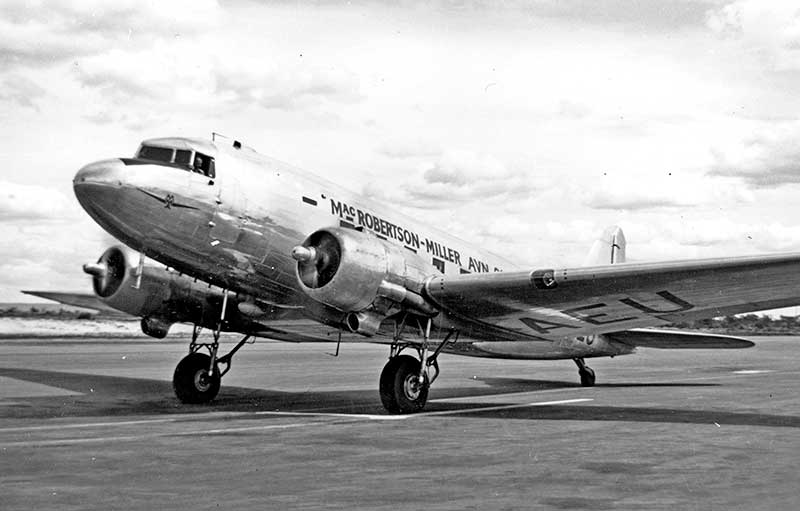

MMA sent senior Captain Cyril Kleinig and chief engineer Frank Colquhoun, who successfully bid for a low-hours C-47A. An import pemit was approved by DCA 18 May 1946 and it was ferried to Perth. After civil conversion to a DC-3 in the MMA hangars at Maylands, it emerged as VH-AXM, test flown on 14 March 1947 and entered MMA scheduled service on 25 March 1947 named "RMA Fitzroy". In October that year it flew MMA's first International charter to India to collect an Indian cricket team.
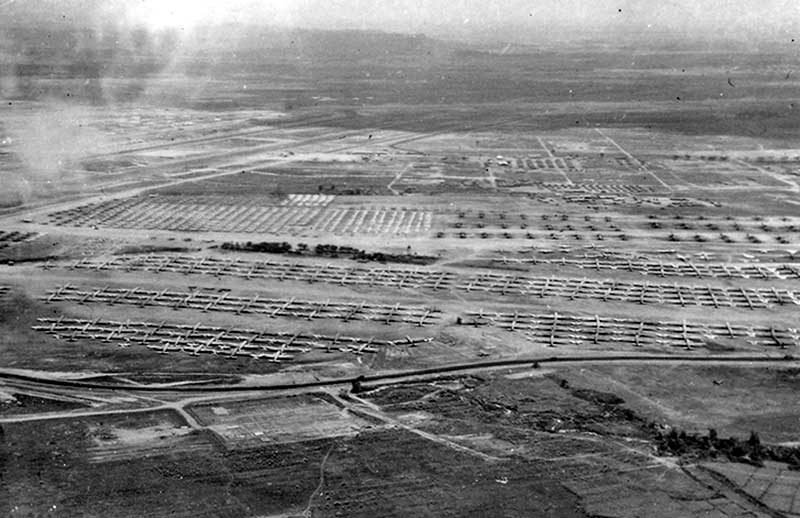

purchase a Douglas C-47 for MMA from US disposals at Clark Field. USAAF Major Stormy Wooles (left) and Major Boland.
Photo: Frank Colquhoun


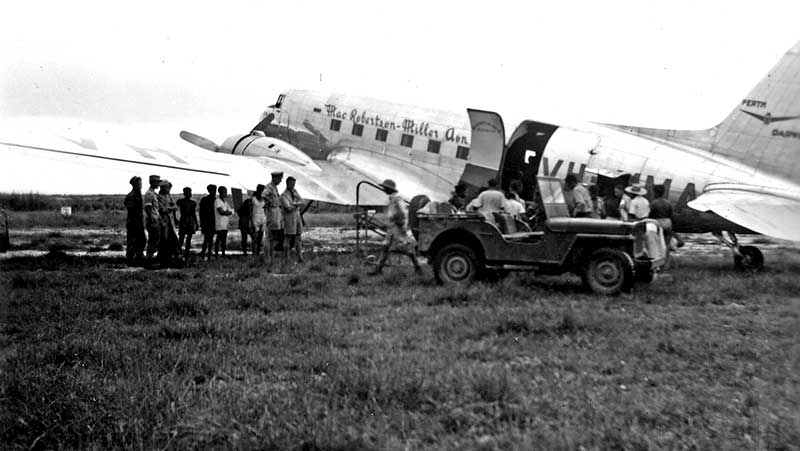
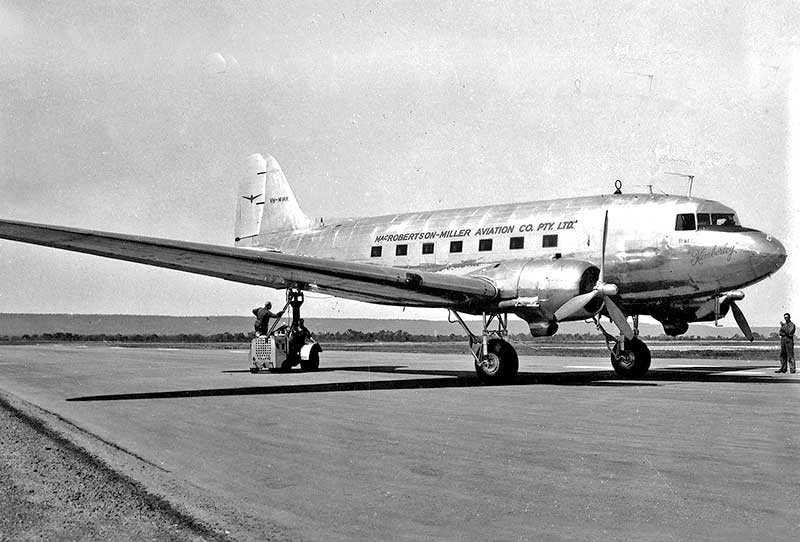
Photo by Frank Colquhoun
Earty in the morning of 2 July 1949, VH-MME took off at Perth Airport on a delayed scheduled service to Carnarvon. The DC-3 rolled on Runway 02 at 2.14am in heavy rain and when airborne rotated violently and went into a steep climb until the aircraft stalled and fell in a disused army camp off the end of the airfield boundary. Captain W.G.Norman, his 3 crew and 14 passengers were killed.
A lengthy Court of Enquiry determined that the cause to be faulty loading of the aircraft resulted in Centre of Gravity being well behind the aft limit, causing loss of control when airborne. Worse, the enquiry found that the vital Load Sheet provided in evidence had been altered by persons unknown and that the company's loading procedures for groundstaff were lax or non-existant. It was unimpressed by evidence given by some senior company personnel, and the final report recommended that MMA's airline licence be suspended or cancelled.
The DCA Director General decided not to take action against the airline licence, but instituted close monitoring of MMA's operational procedures. The casual days had ended.

Geoff Goodall collection
Part of the post-war expansion plan was to acquire a fleet of
civilianised Avro Ansons to operate local services to small towns and
properties from most of the
northern coastal ports. In 1946 large numbers of retired RAAF Ansons were becoming available from
Commonwealth Disposals Commission and DCA approved their use as civil passenger aircraft with a minimum of modifications.
MMA purchased six Ansons at Geraldton at prices of £250 or £350 each. They which were ferried by MMA crews to Maylands for civil conversions. Also purchased was a large stock of RAAF spares parts and Armstrong Siddeley Cheetah engines. Several one-piece wooden mainplanes were loaded on railway freight wagons at Geraldton in November 1946 by MMA groundstaff for transporting to Perth.
Two additional Ansons in poor condition were acquired for engines and parts from RAAF Pearce, 20 miles north of Perth. Frank Colquhoun sawed off their wooden wings outer of the engines then towed each to Maylands Aerodrome by road behind a jeep with the tailwheel attached to a sling. He did the tows at 3am in the morning to avoid road traffic.
The Ansons were fitted out for 6 or 7 passengers with window panels replacing the RAAF cabin perspex glasshouse. The nose was modified to allow baggage storage through a hinged nose cap. They were based between Port Hedland and Darwin to fly scheduled "station runs" to cattle stations, missions and remote towns, as well as Flying Doctor Service contracts. They also flew inland photographic mapping and coastal fishing surveys, proving to be very reliable aircraft.
MMA purchased six Ansons at Geraldton at prices of £250 or £350 each. They which were ferried by MMA crews to Maylands for civil conversions. Also purchased was a large stock of RAAF spares parts and Armstrong Siddeley Cheetah engines. Several one-piece wooden mainplanes were loaded on railway freight wagons at Geraldton in November 1946 by MMA groundstaff for transporting to Perth.
Two additional Ansons in poor condition were acquired for engines and parts from RAAF Pearce, 20 miles north of Perth. Frank Colquhoun sawed off their wooden wings outer of the engines then towed each to Maylands Aerodrome by road behind a jeep with the tailwheel attached to a sling. He did the tows at 3am in the morning to avoid road traffic.
The Ansons were fitted out for 6 or 7 passengers with window panels replacing the RAAF cabin perspex glasshouse. The nose was modified to allow baggage storage through a hinged nose cap. They were based between Port Hedland and Darwin to fly scheduled "station runs" to cattle stations, missions and remote towns, as well as Flying Doctor Service contracts. They also flew inland photographic mapping and coastal fishing surveys, proving to be very reliable aircraft.

Window panels were soon installed to replace the military glasshouse. Photo by Frank Colquhoun

Pilot Alex Whitham stands by the aircraft. Photo by Frank Colquhoun who arrived with the repair crew.


This poor quality snapshot at Perth Airport shows VH-AYP with an unusual window design. Behind is Electra VH-ABV and
the stripped airframe of ex RAAF Lockheed Hudson A16-116 purchased by MMA for engines, instruments and parts.
The Hudson was flown in from RAAF Pearce on 20 May 1947 by Cyril Kleinig and Cyril Goode. Photo: MMA
the stripped airframe of ex RAAF Lockheed Hudson A16-116 purchased by MMA for engines, instruments and parts.
The Hudson was flown in from RAAF Pearce on 20 May 1947 by Cyril Kleinig and Cyril Goode. Photo: MMA

Photo by Phil McCulloch

At the end of the war, the two Lockheed Electras were still in full service
along the Perth-Darwin route. However VH-ABW was written-off in at Broome on 17 June 1946.
Route Manager Captain James Woods was in command for a scheduled early departure. At 5am he taxied to the runway with First officer Rodney Pyke, supernumary pilot Forrest Hammersley and five passengers bound for Darwin. It was still dark and Broome airfield was covered in a thick sea fog with visibility reduced below the minimum distance required for takeoff. Captain Alex Whitham in command of the southbound MMA DC-3 VH-AEU advised Broome Aeroradio that he would delay his departure until the visibility improved. But Woods, who had flown out of Broome since his 1920s West Australian Airways days, was unconcerned and instructed his First Officer to commence takeoff. In zero visibility they became airborne and immediately retracted the landing gear, but a propeller struck the ground and the aircraft lost speed. Woods took over to make a belly landing straight ahead in a muddy mangrove tidal swamp.
It was low tide and the occupants were able to disembark through the door and walk though mud to dry land. There were no serious injuries but Woods and Pyke were hurt and spent 3 days in Broome Hospital. The mail, passengers' baggage and freight was removed from the wrecked aircraft before the tide rose. Alex Whitham supervised removal of instruments, radio and other removable equipment.
James Woods' over-confidence that morning was to cost him dearly. DCA's accident investigation found him solely responsible and suspended his commercial pilot licence. Back in Perth he resumed MMA administration work while undergoing training and testing to renew his pilot licence. But in what must have been an extremely difficult decision, Managing Director Horrie Miller wrote to Woods on 31 December 1946 terminating his employment after 17 years of tireless service to the airline.
Route Manager Captain James Woods was in command for a scheduled early departure. At 5am he taxied to the runway with First officer Rodney Pyke, supernumary pilot Forrest Hammersley and five passengers bound for Darwin. It was still dark and Broome airfield was covered in a thick sea fog with visibility reduced below the minimum distance required for takeoff. Captain Alex Whitham in command of the southbound MMA DC-3 VH-AEU advised Broome Aeroradio that he would delay his departure until the visibility improved. But Woods, who had flown out of Broome since his 1920s West Australian Airways days, was unconcerned and instructed his First Officer to commence takeoff. In zero visibility they became airborne and immediately retracted the landing gear, but a propeller struck the ground and the aircraft lost speed. Woods took over to make a belly landing straight ahead in a muddy mangrove tidal swamp.
It was low tide and the occupants were able to disembark through the door and walk though mud to dry land. There were no serious injuries but Woods and Pyke were hurt and spent 3 days in Broome Hospital. The mail, passengers' baggage and freight was removed from the wrecked aircraft before the tide rose. Alex Whitham supervised removal of instruments, radio and other removable equipment.
James Woods' over-confidence that morning was to cost him dearly. DCA's accident investigation found him solely responsible and suspended his commercial pilot licence. Back in Perth he resumed MMA administration work while undergoing training and testing to renew his pilot licence. But in what must have been an extremely difficult decision, Managing Director Horrie Miller wrote to Woods on 31 December 1946 terminating his employment after 17 years of tireless service to the airline.


It was demanding flying. On 26 September 1949 Captain Sid Goddard made a forced landing in bush in a different area of Napier Downs Station where this aircraft had to be pulled out by donkey team in 1942. This time the gear was down and the aircraft flown out in much quicker time. On 6 October 1952 Captain Jack Murray was landing at Noonkenbah Station when the port undercarriage leg folded, damaging the port wing and propeller. It was back in service on 23 October 1952.

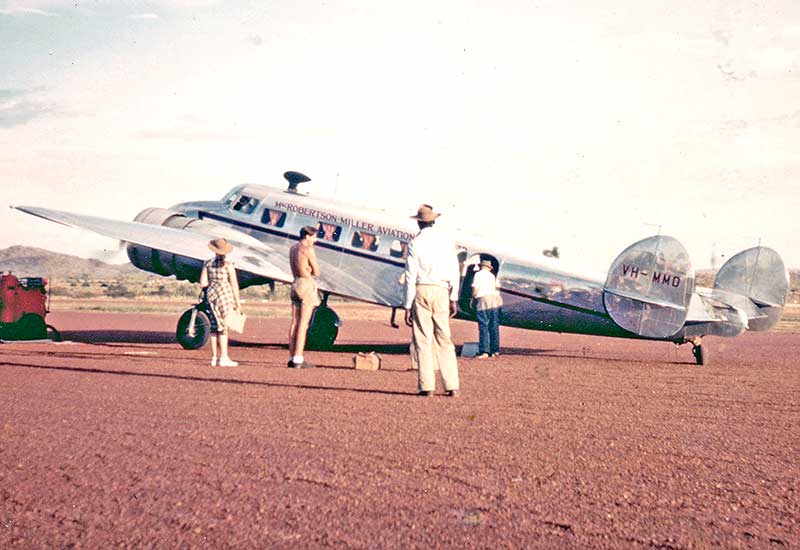

To publicise the project, in July 1946 Captain Cyril Kleinig flew Lockheed Electra VH-ABV from Mount House to Perth delivering four unchilled bullock carcases in perfect condition, which were auctioned to raise funds for Red Cross. Talks to gain Government financing began and Australian National Airways' projects manager Ian H. Grabowsky formulated a detailed plan to use ANA Bristol Freighters.
A new company Air Beef Pty Ltd, was registered in Perth on 4 November 1948 as a consortium comprising MMA, ANA and Kimberley pastoralists. The airstrip at Glenroy was upgraded to DC-3 and Bristol Freighter standard, and in January 1949 MMA commenced flying in building materials to construct the Glenroy abattoir, chilling room, canteen and wartime nissan hut living quarters for 16 butchers, 3 engineers, governmeat meat inspectors, a cook, storeman, clerical staff and aircrew. It was completed in May 1949 when DC-3 VH-MMF and an ANA DC-3 commenced 3 return flights daily from Glenroy to Wyndham, carrying 3 tons of chilled meat. Back-loading was equipment and supplies for the stations, which previously took weeks by truck. The first MMA crew based at Glenroy for the season were Captain Cyril Kleinig, Sturdee Jordan and Bill Pepper.
To maximise its load carrying capability, VH-MMF had its auxiliary fuel tanks, de-icing equipment, sound-proofing and autopilot system removed and the company issued polish for the aircrew to keep the metal gleaming during their time off. ANA used a Bristol Freighter for the Air Beef seasons April-September each year 1950-1953 when they withdrew, leaving flying operations to MMA. A second specialised DC-3 freighter VH-MML was purchased from a British dealer. MMA continued Air Beef each year until 1962 when Air Beef Pty Ltd ceased operations because the Kimberley inland road network had improved to the extent that it was now more economic to move live cattle by trucks to the coastal meatworks.
Between 1949-1962 Air Beef Pty Ltd flew 1,693 return flights Glenroy-Wyndham and 1,149 return flights Glenroy-Derby, carrying a remarkable total of 14,393 tons of meat from the Glenroy Station abattoir.

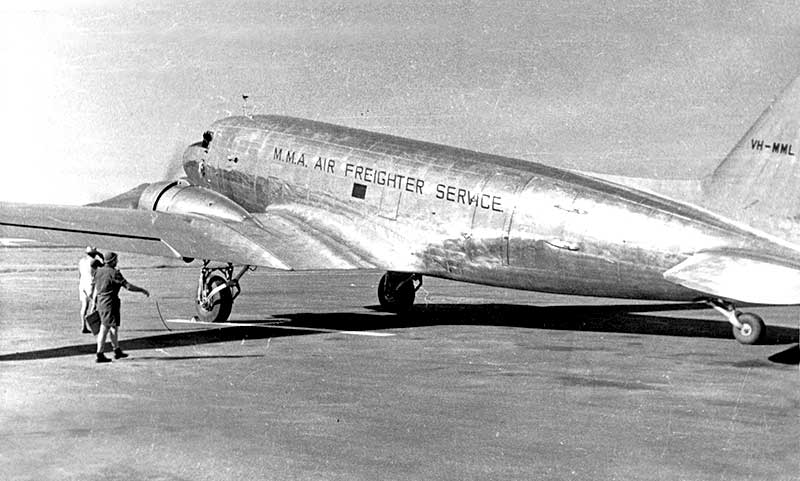
Photo by Colin Hayes

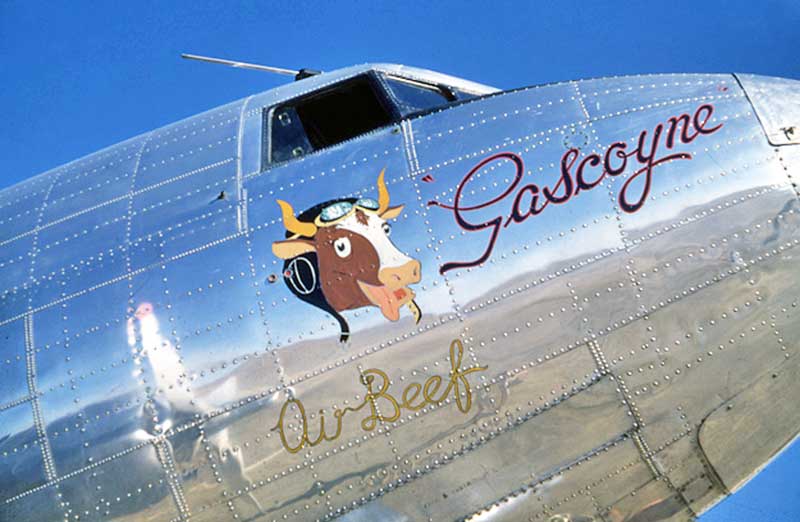
At that time MMA crews were posted to Glenroy for the full 4 month season. Photo by Colin Hayes

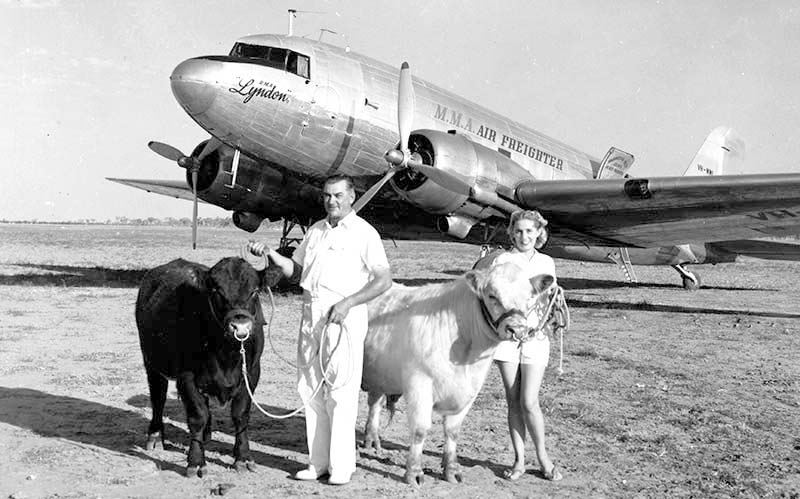
Photo: Geoff Goodall collection
- MacRobertson-Miller Aviation Company
- MacRobertson-Miller Aviation Company Ltd
- MacRobertson-Miller Aviation Company Pty Ltd
- Commercial Aviation Company
- Commercial Aviation Pty Ltd: the original Adelaide business was retained and restructured as a WA business under this name. It was used as a MMA subsidiary, mainly for accounting purposes to which MMA aircraft ownership was transferred from time to time.
Government reviews of Australian airline subsidies expressed concern at WA duplication where MMA and Airlines were both receiving subsidies along variations of Perth-Meektharra-Wittenoom-Port Hedland. It came to a head in 1955 when the Minister for Civil Aviation, Mr Atholb Townley stated it could not continue and called on the two airlines to merge. Talks began to discuss how this could be achieved. MacRobertsons Pty Ltd of Melbourne still owned 62% of MMA shares while Airlines (WA) Ltd was a public company listed in Perth.
During June 1955 a new company MacRobertson Miller Airlines Ltd (no hyphen) was established to continue the merged operations of both airlines. The Managing Director position was initially shared by Cyril Kleinig from MMA and Don Cameron from Airlines. The merger included management, admin and booking staff, pilots and engineering staff in addition to aircraft and building assets. It was an uncomfortable period at first with differing management and operational procedures and staff seniority to be standardised. Although it was stressed to be a merger, not a takeover by MMA, in reality it seemed to most to be just that.
Combined operations commenced 1 October 1955 when MacRobertson Miller Airlines had a combined staff of over 400, including 49 pilots. Chief Pilot was Captain Alex Whitham, Managing Director Cyril Kleinig with James Cameron, previously Managing Director of Airlines (WA) Ltd appointed Executive Manager. Chairman of the new combined Board was Perth businessman Reginald Rushton.


Photo by Peter R. Keating


| VH-MMN | 04104 | RMA Nullagine | ex VH-AWA | Sold 12.67 to Dept of Health for NT Medical Service, Darwin as VH-DHD |
| VH-MMO | 04091 | RMA Ord | ex VH-AWD | Sold 8.66 to Richards Renta-Plane/ Union Air, Toowoomba Qld as VH-RUW |
| VH-MMP | 04119 | RMA Pallingup | ex VH-AWF | Sold 4.59 to Robbys Aircraft Service, Adelaide as VH-RAJ |

Photo: Geoff Goodall collection

Despite the widely-held belief that Managing Director Cyril Kleinig refused stating the weight of the paint would reduce
payload, this rare picture of VH-MMM "Murchison"in March 1957 at Esperance shows that it was trialled for a period.
Photo via Nicholas Kleinig

In the north, airport facilities were still basic. Here's the passenger waiting area at Port Hedland in 1956.
Planting the desert shrubs was a a nice touch. Photo via Reg Adkins
Planting the desert shrubs was a a nice touch. Photo via Reg Adkins

Frank Colquhoun collection



on 11 August 1962 by Chief Pilot Alex Whitham who is wearing his cap in the centre with Managing Director Cyril Kleinig,
handing over the aircraft's log books to the school Head Master. Sadly the aircraft was soon wrecked by student vandalism.
Photo: Geoff Goodall collection
| VH-AYN | W1232 | 1.11.46 | RMA DeGray | VH-MMG 4.49 | Crashed 4.2.56 Hawkstone Peak, Kimberley on RFDS emergency flight, all 5 killed |
| VH-AYO | W2088 | 25.10.46 | RMA Ord | VH-MMH 4.49 | Later RMA Harding. Retired Perth 30.6.62 |
| VH-AYP | W2045 | 26.4.47 | RMA Greenough | VH-MMI 4.49 | Retired Perth 19.5.50, broken up for parts |
| VH-AYQ | W2015 | 20.12.46 | RMA Drysdale | VH-MMJ 4.49 | Sold 27.3.58 Carsair, Port Moresby PNG |
| VH-MMB | W2070 | 18.6.47 | RMA Fortesque | - | Retired Perth 5.3.59 |
| VH-MMC | R3548 | 24.7.47 | RMA Strelley | - | Sold 13.9.56 Patair, Port Moresby PNG |
MMA negotiated the purchase of VH-TFL whlle it was on the Fokker production line. It was delivered from Fokker's Amsterdam factory to Perth by MMA Captains Alex Witham and Sid Goddard, arriving at Perth Airport on 16 December 1959. It had been painted by Fokker in a newly-designed blue, white and red MMA Jetstream Service scheme.
The F.27 was repainted as VH-MMS with name RMA Swan during its pre-service overhaul at Perth. Crew training commenced and a naming ceremony on 28 December was a lavish affair which gained wide publicity. Following the ceremony, dignitaries and press boarded for a flight to Port Hedland and return, on which hot meals were served, a first for MMA due to the limited DC-3 galley facilies. The inaugural revenue flight for the Friendship was a scheduled 5am departure Perth-Port Hedland-Broome-Derby crewed by Captains Syd Goddard and Ken Beer and F/O Norm Dorrington. The F.27 took over the Perth-Darwin mainline schedule, leaving the DC-3s to cover the coastal ports and station services. VH-MMS operated an average of 10 hours flying time per day, 7 days a week logging over 3,000 hours in the first year, all maintenance at home base Perth overnight.

Geoff Goodall collection
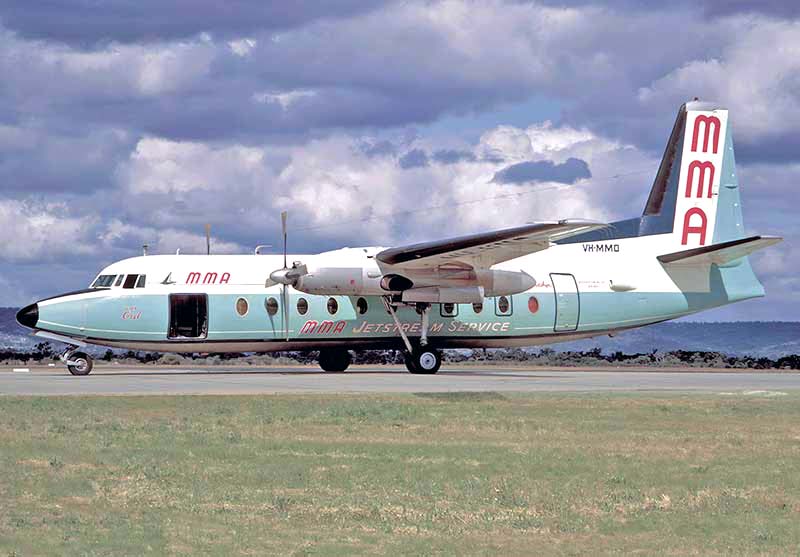
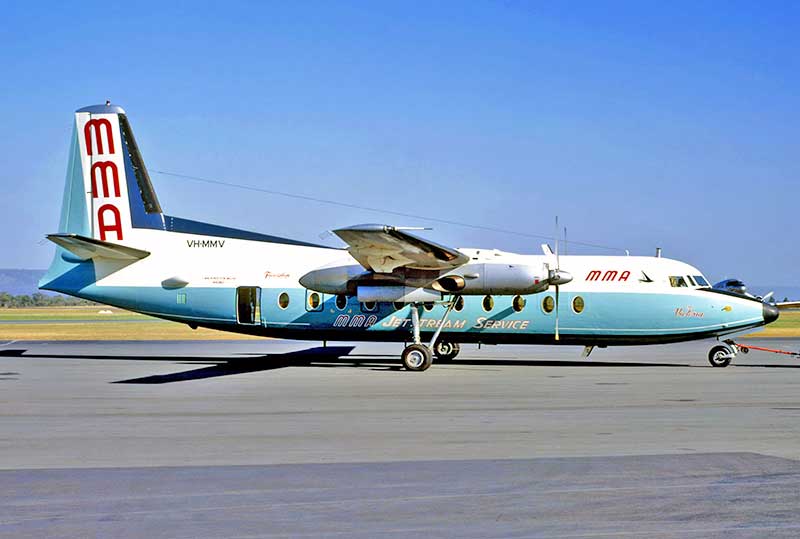
Ansett's move into Western Australia came in 1963 when MacRobertson Pty Ltd in Melbourne, the original partners, wanted to sell their 50% shareholding in MMA to finance expansion of their chocolate business. Horrie Miller, now aged 70 and living in retirement at Broome, held the next biggest shareholding. Ansett took over MMA by purchasing MacRoberson and Horrie Miller's shares plus taking over the outsanding payments due to TAA on the first F.27 VH-MMS.
On 19 April 1963 MacRobertson Miller Airlines Ltd became a subsidiary of Ansett Transport Industries. Many people of the North at first were critical of Horrie Miller, who was seen as selling out their essential air service to a big Eastern States conglomerate for personal profit. The reality was that Miller was crucially aware that the existing company simply could not finance the all-turbine airliner fleet it needed to stay in business. Reg Ansett had learned from his previous airline purchases when he changed their names and replaced experienced management that loss of local goodwill resulted in rearly reduced turnover - he assured the MMA Board that ATI would adopt a hands-off policy to allow MMA to continue under the same management apart from the two MacRobertson directors would be replaced by R.M.Ansett and Fred Pascoe representing ATI. Cyril Kleinig continued as Managing Director.
The impact of solid financial backing came at just the right time. Massive reserves of iron ore in the Pilbara district inland from Port Hedland and Dampier had resulted in huge new mining operations being built and new towns for their employees with air-conditioned brick homes boasting gardens and lawns, shopping centres, medical services and other amenities. These mining centres and their coastal iron ore shipping ports had new airports with modern facilities constructed by the mining companies and were added to the MMA timetable during the 1960s: Mount Newman, Paraburdoo, Mount Tom Price, Karratha. Port Hedland's port went from a weekly Coastal Ships visit to a vast development which loaded the largest bulk ore carriers for shipping to Japan.
The MMA Board could now place firm orders for new F.27s and consider the new medium-sized jet airliners for the future. But in the meantime capacity on services to the Pilbara were stretched to the limit. Air cargo rose by 54% in the 1965-66 financial year.
Ansett-ANA F.27s were leased to MMA for varying periods, and two Ansett-ANA Douglas DC-4s leased: VH-INX from August 1965 initially as as a freighter and VH-INY from November 1965 in 54 passenger configuration and freight, all flown by MMA crews. VH-INX returned to Melbourneon 20 July 1966 from extended MMA service.
DC-3s were leased from East West Airlines at Tamworth NSW: VH-EWE for two weeks from 17 July 1965, VH-EWD two weeks from 13 August that year, followed by VH-EWB from 6 October 1965 for three months. Each was collected from Tamworth by MMA crews and ferried to Perth. EWB was returned to Tamworth by an MMA crew on 15 January 1966.
A three year lease of a Philippine Airlines F.27 commenced in January 1966, painted in MMA Jetstream Service scheme as VH-MMU with the non-standard name "Mabuhay", the Filipino greeting. It was a Friendship Mk.1 series which did not have the performance of MMA's Mk.2s and was not popular with flight crews. It also suffered significant maintenence problems which caused so many customer complaints that questions were asked in State Parliament. It was ferried back to Manila in November 1968 by MMA Captains Bill Anderson and Sid Goddard



temporarily replaced with a MMA spare unit. The DC-7 behind was the weekly South African Airways service.
Photo by Merv Prime

Photo via Nicholas Kleinig

WA Petroleum Ltd (WAPET) was establishing its first oil field on Barrow Island, off the WA coast near Exmouth. It was to grow to over 400 wells and the island become Australia's leading supplier of oil and natural gas. In 1963 WAPET called for tenders to provide a dedicated air service to carry personnel and supplies between Perth, Barrow Island and other WAPET inland drilling sites, with 750 hours flying per year. After evaluating aircraft types best suited to the contract requirements, MMA prepared a tender based on an 8 passenger Piaggio P.166. The bid was successful. and the contract signed in November 1963 to be operated by its subsidiary company Commercial Aviation Pty Ltd using crews and facilities loaned by MMA. A four year old P166 was purchased from the British dealers, registered VH-MMP and delivered to Perth. The ferry pilot was Australian Captain Brian Monkton, founder of Trans Oceanic Airlines, Sydney in 1946 and now a freelance commercial pilot in Europe and Africa.
The Piaggio reached Perth on 27 February 1964 after an eventful delivery flight, culminating in Monkton being forced to shut down one engine while crossing the Timor Sea and being escorted into Darwin by a RAF Hastings and RAAF Dakota. After the engine was repaired, he was then delayed a week at Broome when the other engine failed and was replaced with a spare flown up from Perth with MMA engineers. Unfortunately engine and undercarriage serviceability problems were to plague the aircraft on the WAPET contract, when it was usually flown by MMA Captain Ron Eastman. The contract was lost after the first year's review and taken over by a Perth charter firm.
The Piaggio was then used for general charter and to carry company engineers to u/s airliners along the routes. In January 1966 it appeared in the MMA timetable substituted for the normal DC-3 on the 4 days a week return service Perth to Mount Magnet, Cue, Meekatharra, but it is reported to have struggled in the high summer temperatures and DC-3s went back on the run. In 1967 the Piaggio was retired and advertised for sale in Australia and overseas. With no sale, it finally departed Perth in October 1969 for lease to Ansett Airlines of Papua New Guinea but, true to form, went u/s at Horn Island on the delivery flight and never reached New Guinea. Ironically, VH-MMP was to go on to a long and productive life with various charter operators and by the 1990s was the last Australian Piaggio still flying.



Both photographs by Merv Prime


Photo by Merv Prime


With a new title Regional Director, Miller moved to Broome, 2000 km north of Perth and semi-retirement.
Miller had married Mary Durack (later Dame Mary) whose family were Kimberley pioneer pastoralists. Horrie had met the Duracks during his stops at their cattle stations while setting up the MMA Kimberley services. Mary became a noted artist, author and poet, the Miller Nedlands home in Perth becoming a hub for the literary and social set of the day. Horrie, a more solitary person, later bought a house in Broome where he spent much of his time with regular visits from his family. They had six children, Julie became an MMA hostess and Robin was widely known across the north of WA as the Sugarbird Lady - as a nurse for the WA Health Department she flew her own light aircraft to remote communities administering polio vaccine in sugar cubes. Robin was later an RFDS pilot at Perth before an untimely terminal illness.
Horrie purchased a civilianised former RAAF CAC CA-6 Wackett Trainer VH-AIY from a Sydney aircraft dealer in June 1946 and flew it to Perth for his personal use. When he settled in Broome the Wackett was based at Broome Airport, maintained by MMA engineers stationed at Broome or Derby. By 1964 Horrie was aged 71 and let his pilot licence lapse. His Wackett was retired in its Broome hangar which still had bullet holes from the Japanese air raid in 1942. He held his seat on the MMA Board and traveled to Perth for Directors meetings until his formal retirement in 1972.
Part of MMA folklore was Horrie Miller's habit of meeting every MMA flight through Broome, day or night. Captain Reg Adkins describes it in his excellent book I Flew For MMA:
"I did my first flight through to Darwin in May 1955 as F/O to Captain Phil Dickson. When we arrived at Brome, an elderly man wandered over. Phil said "See that old bloke over there? He's your boss. That's Captain Horrie Miller". By now aged 62, Horrie had retired to Broome but always met every flight, wearing his standard uniform of white shirt, khaki shorts, long socks and shoes. When the stairs were rolled up he was always first on the aeroplane, with a gleam in his eye he would chat to the Hostess in his slow quiet drawl, then pick up a newspaper before greeting the Captain for a yarn to catch up on news along the track. One new Hostess who rebuked him for taking a newspaper got a shock when told that the old chap she has just chewed out was the owner of the airline.
That was Horrie in Broome - living in the peace and quiet of that little sleepy coastal town of the time - and quite happy there, just watching his aeroplanes come and go. There was always a feeling of being in the presence of history when you were with Horrie.
Shirl and I went to see him years later, back at his home in Nedlands in his final days, sitting in an armchair with a rug around him and not being able to say much at all but still that gleam in his tired old eyes. One of Australia's real pioneer aviators, he was a great bloke and the founder of a great airline."
Awards and recognition came late in Horrie Miller's life. In 1977 he was the recipient of that year's Oswald Watt Gold Medal for achievements in aviation. In 1978 he was awarded an Order of the British Empire (OBE). A road to the new International Terminal at Perth Airport was named Horrie Miller Drive. WA Premier Sir Charles Court later wrote "During my long personal acquaintance with Horrie Miller I could not decide what motivated him. Not for him the headlines, the notoriety or fame that others attracted. His great satisfaction was in achievement. He never boasted or made dramatic claims what he had achieved but was always generous in his praise of others.
Horace Clive Miller died in Perth on 27 September 1980. At his funeral, in an improptu action, MMA Captains and Hostesses attending in uniform formed an honour guard to show their personal respect. The next Fokker Fellowship to be delivered VH-FKG was named
RMA Horrie Miller by his widow Dame Mary Durack in a ceremony at Broome Airport in August 1981.
One can only wonder at Miller's feelings in 1963 when he agreed to sell to Reg Ansett his shareholding in the company he formed 35 years earlier. I can only assume it was Ansett's personal assurance that he would leave MMA under its current management that was the deciding factor. Reg Ansett did honour that pledge, at least for the first decade of Ansett ownership.

Captain Dave Campbell and hostess Marge Kitley from the MMA DC-3 VH-MMD "Durack".
Frank Colquhoun collection

 | |  |
Despite its age, having been built in 1955 for Butler Air Transport, Sydney, the Viscount brought "big airliner" prestige for MMA. In the expectation that MMA would be operating Viscounts for some years, an extensive pilot training and endorsement program kept VH-RMO busy most evenings with circuits and instrument approaches at Perth in those days prior to Simulators.
In September 1968 Viscount 720C VH-RMQ replaced VH-RMO as part of a routine Ansett-ANA flight hours maintenance schedule.
RMO was repainted back to Ansett-ANA scheme before departing Perth 8 September for Melbourne, RMQ ferrying Melbourne-Perth on 13 September and going into the MMA paint shop that same night to emerge in Jetstream Service scheme with name RMA Quininup. This was an even older aircraft, first flown in October 1954 for TAA.
DCA grounded all Australian Viscount 700s. Because of different wing construction, Viscount 800s of Ansett and TAA were not affected but they were soon retired, replaced by newly delivered DC-9 jets.


The MMA operating name was changed to: MacRobertson Miller Airline Services - A Division of Ansett Transport Industries (Operations) Pty Ltd. Cyril Kleinig remained in charge but with new title Genreal Manager. It signalled a decade of increased Ansett influence in all aspects of MMA's operations which would culminate in the elimination of the MMA name.

Press and TV publicity was arranged for the final MMA DC-3 scheduled service on 17 January 1969 when VH-MMA operated Newman-Meekatharra-Perth on 17 January 1969. The aircraft had logged a total of 54,600 flying hours.
ATI transferred VH-MMA and VH-MMD to Ansett-MAL, which had just been renamed Ansett Airlines of Papua New Guinea. Both were repainted at Perth in an interim colour scheme and VH-MMD was first to depart on delivery to Lae on 10 February 1969 via refuelling stops at Forrest, Whyalla, Broken Hill, Rockhampton and Cairns. VH-MMA followed on 17 February along the same route.
Other DC-3s were sold to Australian Aircraft Sales, Sydney. MMA's DC-3s were considered among the best maintained examples of the type, so were quickly resold by AAS despite large numbers on the worldwide market as airlines upgraded their fleets.



Photo by Nigel Daw
VH-ANZ had the honour of operating MMA's final DC-3 scheduled service on 29 August 1970, Port Hedland-Perth, but the occasion received no publicity. It was parked on the grass at Perth Airport and sold to Australian Aircraft Sales. VH-ANX continued with occasional freight work for another year until March 1972 when ferried away by AAS.


VH-ANZ departs Perth on 4 January 1971 with Australian Aircraft Sales
logo and MMA markings painted over.
Photo by Merv Prime
Photo by Merv Prime
| VH-AEU | 6108 | 11.45 | - | 41-19465 | leased ex DCA. Returned 3.47, to TAA |
| VH-AXM VH-MME | 9350 | 5.47 | RMA Fitzroy | 42-23488 | rereg 12.48 as VH-MME Crashed 2.7.49 on take off Perth Airport |
| VH-MMA | 9593 | 10.47 | RMA Ashburton | A65-13 (RAAF) | retired 1.69 Perth, departed 17.2.69 on delivery to Ansett Airlines of Papua New Guinea |
| VH-MMF | 12540 | 4.49 | RMA Fortesque | A65-41 (RAAF) | departed Perth 7.3.70 on delivery to Ansett Airlines of Papua New Guinea |
| VH-MMK | 19950 | 8.49 | RMA Durack RMA Kimberley | VH-BHB Zinc Corporation | retired 1.69 Perth sold 5.69 to Australian Aircraft Sales, Sydney departed Perth 2.6.69 to Far East Air Transport, Taiwan as B-257 |
| VH-MML | 32945 | 4.54 | RMA Gascoyne RMA Lyndon | G-ANMA, Pakistan H717 | departed Perth 10.1.69 on delivery to Ansett Airlines of Papua New Guinea |
| VH-MMM | 13612 | 4.55 | RMA Murchison | VH-AVK Guinea Airways | retired 1.69 Perth sold 5.69 to Australian Aircraft Sales Sydney departed Perth 6.7.69 to Far East Air Transport, Taiwan as B-251 |
| VH-MMD | 33301 | 10.58 | RMA Durack | A65-119 (RAAF) | retired 1.69 Perth, departed 10.2.69 on delivery to Ansett Airlines of Papua New Guinea |
| VH-MMO VH-MMB | 34228 | 12.62 | RMA Ord RMA Blackwood | ZK-AOH (NZNAC) | delivered ex Christchurch 10.12.62 painted as MMA VH-MMO RMA Ord, rereg 20.12.62 VH-MMB RMA Blackwood retired 1.69 Perth sold 5.69 to Australian Aircraft Sales , Sydney departed 30.5.69 on delivery to Merpati Nusantara Airlines as PK-NDG |
| VH-MMT | 6353 | 6.65 | RMA Turner | VH-MJL Aero Service Ltd | delivered ex Sydney 19.6.65, ex aerial survey retired 1.69 Perth sold 5.69 to Australian Aircraft Sales Sydney departed Perth 12.10.69 for Essendon, delivered 11.69 to Seulewah Air Services, Jakarta as PK-RDG |
| VH-ANX | 18949 | 3.70 | - | 42-100486 | Delivered to Perth 3.3.70 Ansett-ANA Cargoliner, repainted Perth in MMA scheme, freighter use, sold to Australian Aircraft Sales, Sydney Departed Perth 12.3.72 to Essendon, delivered 8.72 to Island Air Transfer, Honolulu as N99131 |
| VH-ANZ | 9559 | 3.70 | - | 42-23697 | Delivered to Perth 8.3.70 Ansett-ANA Skyliner, repainted Peeth in MMA scheme, passenger use Sold 12.70 to Australian Aircraft Sales, Sydney Departed Perth 4.1.71 to Essendon, delivered 7.71 to United Khymer Airlines, Cambodia as XU-IAL |
The first of the ATI order for F.28 Fellowship 1000 Series was not due for delivery to MMA until mid 1970. Increasing passenger and freight demand and the loss of the Viscount caused ATI to negotiate with Fokker to lease a Fellowship 1000 with an earlier delivery date. Norwegian airline Braathens-SAFE agreed to release a new F.28 still on the production line for a 10 month lease to MMA. The F.28 was completed in MMA paint scheme as VH-MMJ and made its first flight on 30 June 1969 with Fokker temporary test registration PH-ZAH. After the test flight program and crew training, VH-MMJ departed Amsterdam 16 August 1969 for Australia, flown by MMA Captains Sid Goddard and Nelson Hill with Ansett Captain John Withecombe. They reached Perth three days later but continued on to Melbourne for Australian certification inspection in the Ansett hangars at Essendon Airport. Emerging with name RMA Pilbara painted on the nose, VH-MMJ was ferried back to Perth on 24 August for an intense training period.
The great day came on 2 September 1969 when MMA entered the pure jet age with the first Fellowship service Perth-Port Hedland return. It should have been the previous day but VH-MMJ went u/s pre-taxy and to everyone's disappointment an F.27 had to be substituted. The new F.28 was kept on the high-demand Port Hedland run until February the following year when it continued to Kununurra, then hub of the Ord River Scheme. VH-MMJ was now achieving over 8.5 hours daily utilisation, which grew as other ports were ready for the jet.
First of MMA's own Fellowships VH-FKA was delivered to Perth on 8 June 1970 and taking over the name RMA Pilbara, entered service three days later The leased VH-MMJ made its last revenue service on 10 June and departed Perth 13 June 1970 on ferry back to Amsterdam, diverting enroute to be demonstrated to Royal Nepal Airlines.
The next F.28 VH-FKB RMA Kimberley arrived at Perth 12 July 1970, followed by VH-FKC RMA Arnhemland on 20 October 1970.
MMA operated its Fellowships with seating configuration for up to 75 passengers.

Photo by Geoff Goodall
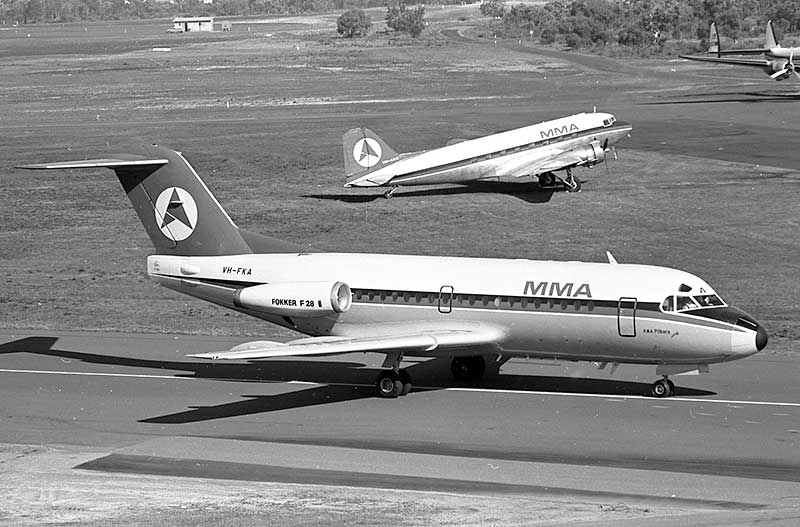

Note the revised company name
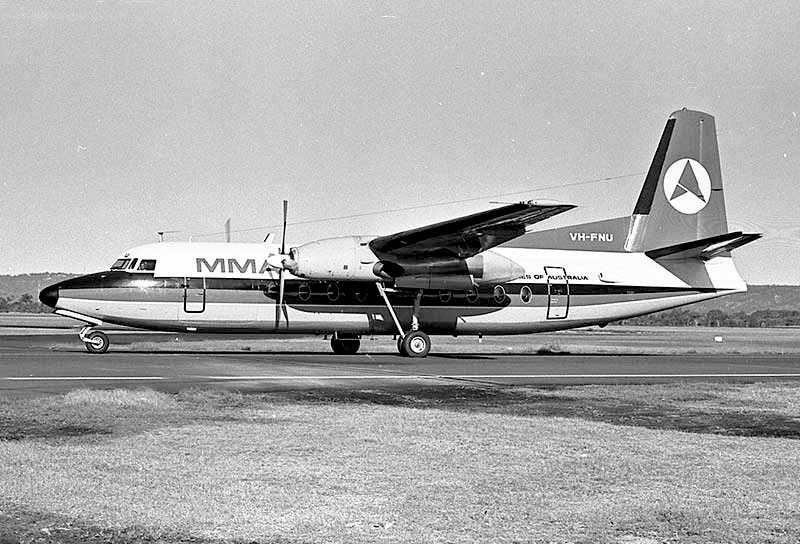
| VH-MMS | 10139 | 12.59 | RMA Swan | (VH-TFL) PH-FBG test reg | F.27 Model 2002 Delivered new to Perth 16.12.59 ex Amsterdam Entered MMA scheduled service 31.12.59 Departed Perth 8.1.72 on delivery Ansett Airlines leased to MMA June-July 1977. |
| VH-MMO | 10146 | 7.64 | RMA Ord | VH-FNF PH-FBL test reg | F.27 Model 2013 Delivered to Perth 16.6.64 ex Ansett-ANA Entered MMA scheduled service 16.7.64 Departed Perth 1.8.70 on delivery Ansett Airlines 2 leases to MMA November 1970-July 1971 |
| VH-MMU | 10258 | 1.66 | Mabuhay | PI-C512 PH-FFZ test reg | F.27 Model 1062 Delivered to Perth 24.1.66 leased ex Philippine AL Departed Perth 13.11.68 as PI-C512 on return to PAL |
| VH-MMR | 10303 | 7.66 | RMA Robe | PH-FIX test reg | F.27 Model 2101 Delivered new to Perth 26.7.66 ex Amsterdam Entered MMA scheduled service 28.7.64 Departed Perth 11.4.71 on delivery Airlines of NSW |
| VH-MMV | 10355 | 3.68 | RMA Victoria | PH-FMB test reg | F.27 Model 2101 Delivered new to Perth 8.3.68 ex Amsterdam Entered MMA scheduled service 3.68 Departed Perth 31.7.71 on delivery Ansett Airlines |
| VH-MMB | 10186 | 8.70 | (no name) | PH-FSG test reg D-BAKU LTU PH-FSG Fokker D-BAKU LTU PH-FDA Fokker | F.27 Model 3026 Previously with LTU, Dusseldorf since new 12.61 Leased to Luxair, Luxembourg 1966-67 Leased to Sabena 1968-69 Delivered to Perth 10.8.70 as VH-MMB Entered MMA scheduled service 18.8.70 (no name) Last MMA service 7.3.71, sold to Fokker who resold to East West Airlines, Tamworth NSW Departed Perth 16.3.71 on delivery to EWA |

A photographer was called out to record this 5AM freak of scheduling. Four had departed by 6AM.
- VH-FKA 17 January 1974: Captain George Beamish was making a night approach to Broome at 3.38am in heavy monsoonal rain when a combination of factors resulted in the aircraft rolling off the end of the runway paved surface at low speed and the nose wheel sank into soft earth. The only damage were minor dents to the nose undercarriage doors and none of the 60 persons on board were hurt, but it looked like a serious accident. The company wanted the aircraft moved as soon as possible to avoid unwanted publicity, but the ground was too soft to get lifting equipment in place for four days. VH-FKA was then ferried back to Perth and quickly returned to service. It had 11,007 airframe hours at that time.

First airline jet to land at Darwin was an MMA F.28 flown from Perth by Captains Sid Goddard, Rodney Kralert and Lindsay Allen. Darwin-bound passengers were off-loaded at Kununurra because entry to the disaster city was barred. Ground and air communications with Darwin had been wiped out. Carrying return fuel, they flew to Darwin and returned to Kununurra with the first load of evacuees including 8 MMA flight crew overnighting at Darwin when the Cyclone hit.
MMA F.28s maintained a shuttle between Kununurra and Darwin. Ansett, TAA and Qantas joined the airlift from the Eastern States and military aircraft. A Qantas Boeing 747 with 365 seats took out 694 passengers including children on the floor secured by rope.
MMA Captain Graham Hewitt went in on 27th December when low cloud was expected. Darwin Airport radio nav aids were u/s so he tracked via Katherine to back-track into Darwin on the Katharine aids. Approaching Darwin the aircraft's weather radar identified the coastline and he descended over the sea, becoming visual at 800 feet. At the airport terminal there were thousands of anxious people. Hewitt loaded 115 people on his 60-seat Fellowship and departed to Kununurra. The following evening he was flying evacuees from Kununurra to Perth with a refuelling stop at Newman. Graham recalls his surprise on landing at the mining town; "All the ladies of Newman had come out to the airport with tea and coffee and sandwichs in the middle of the night. It was a wonderful spread for these poor buggers who were still in a state of shock". Fresh nappies for the mothers with babies were also supplied at Newman.
MMA flights averaged 80 passengers, although Harold Rowell carried 98 passengers on one flight. At Perth Airport an evacuation processing centre was set up in the DCA hangar for arriving MMA F.28s and RAAF C-130s.
| VH-MMJ | 11013 | 9.69 | RMA Pilbara | PH-ZAH test reg | Delivered new to Perth 19.8.69 leased ex Fokker Entered MMA scheduled service 2.9.69 |
| VH-FKA | 11021 | 6.70 | RMA Pilbara | PH-ZAS test reg | Delivered new to Perth 8.6.70 ex Amsterdam Entered MMA scheduled service 11.6.70 |
| VH-FKB | 11022 | 7.70 | RMA Kimberley | PH-ZAT test reg | Delivered new to Perth 12.7.70 ex Amsterdam Entered MMA scheduled service 16.7.70 |
| VH-FKC | 11025 | 10.70 | RMA Arnhemland | PH-EXF test reg | Delivered new to Perth 20.10.70 ex Amsterdam Entered MMA scheduled service 25.10.70 |
| VH-FKD | 11026 | 4.71 | RMA Goldfields | PH-EXA test reg | Delivered to Perth 14.4.71 ex Airlines of NSW Entered MMA service the same morning |
| VH-FKE | 11040 | 10.71 | RMA Gascoyne | - | Delivered new to Perth 27.9.71 ex Amsterdam Entered MMA scheduled service 3.10.71 |
By the end of the decade ATI was planning more changes for MMA. It was time for a new name and a new image.
Ted Karasek continued as General Manager but a new board was appointed. Chairman Neil Batt was from the TNT Group which, with News Ltd, had won control of ATI earlier that year. The airline that MMA built was now fully absorbed into ATI's corporate business.
Airlines of Western Australia was not to last for long, rebadged as Ansett WA in October 1984 and introducing BAe146s to replace the Fellowships.




- Early Birds, H. C. Miller, Rigby 1968
- Flying Nurse, Robin Miller, Rigby 1971
- I Flew For MMA - An Airline Pilot's Life, R.C.Adkins, self-published Perth 1996
- Cockpit and Spanner - My recollections of early aviation in WA, Frank Colquhoun, Maylands Historical Society 2001
- Speck in The Sky, Frank Dunn, Airlines of WA 1984
- Jimmy Woods, Flying Pioneer, Julie Lewis, Fremantle Arts Centre Press 1989
- The Wandering Years, Arthur H. Affleck, Longmans 1964